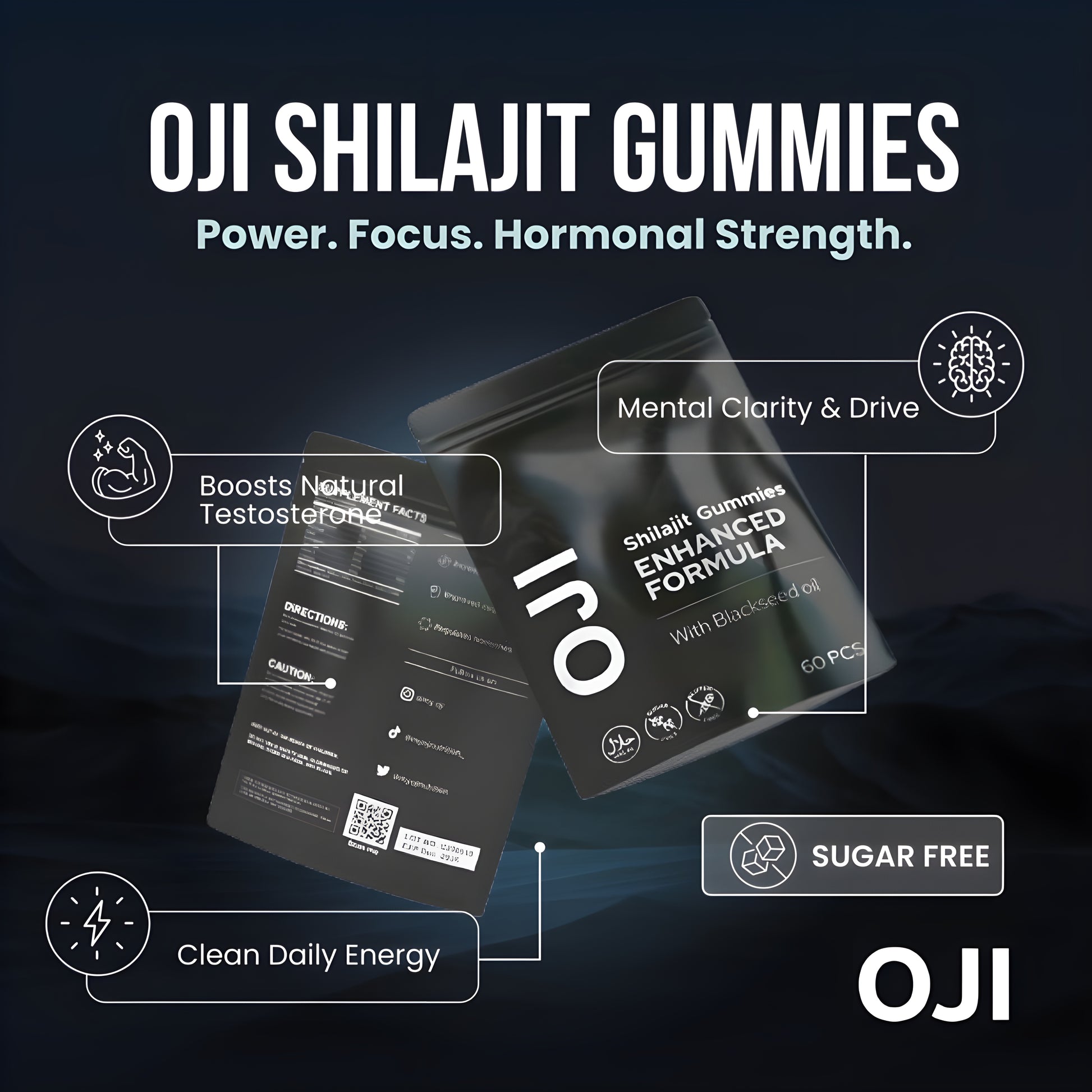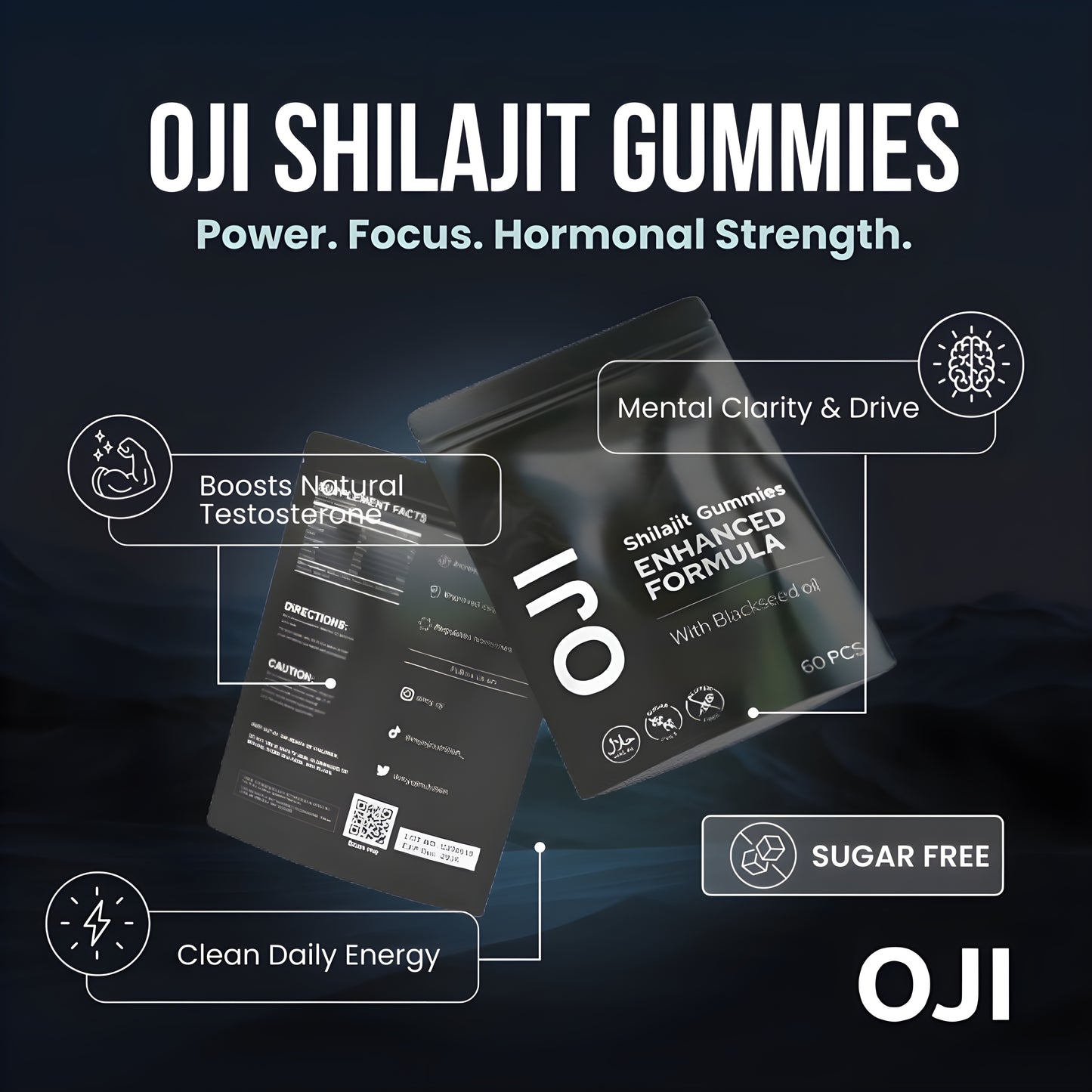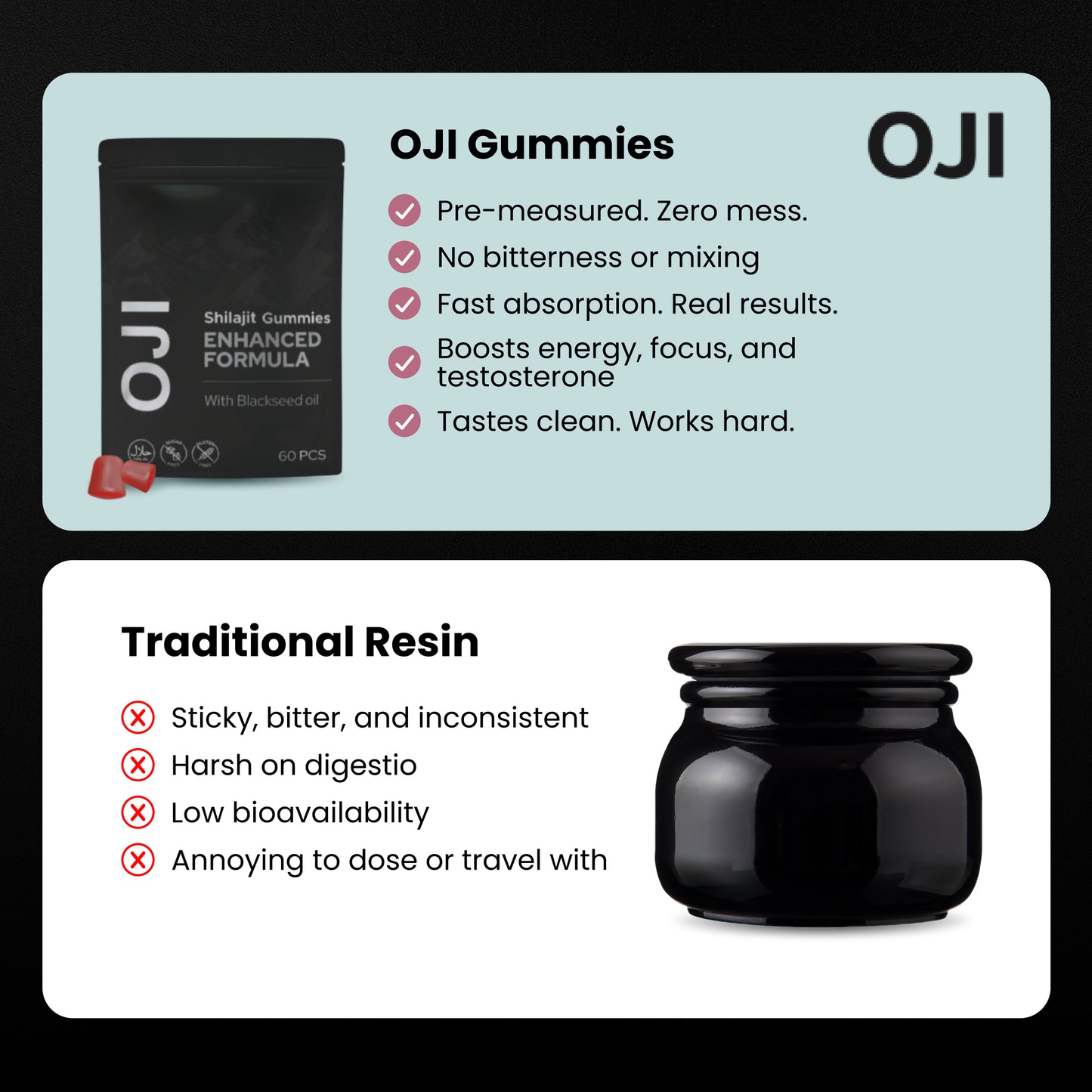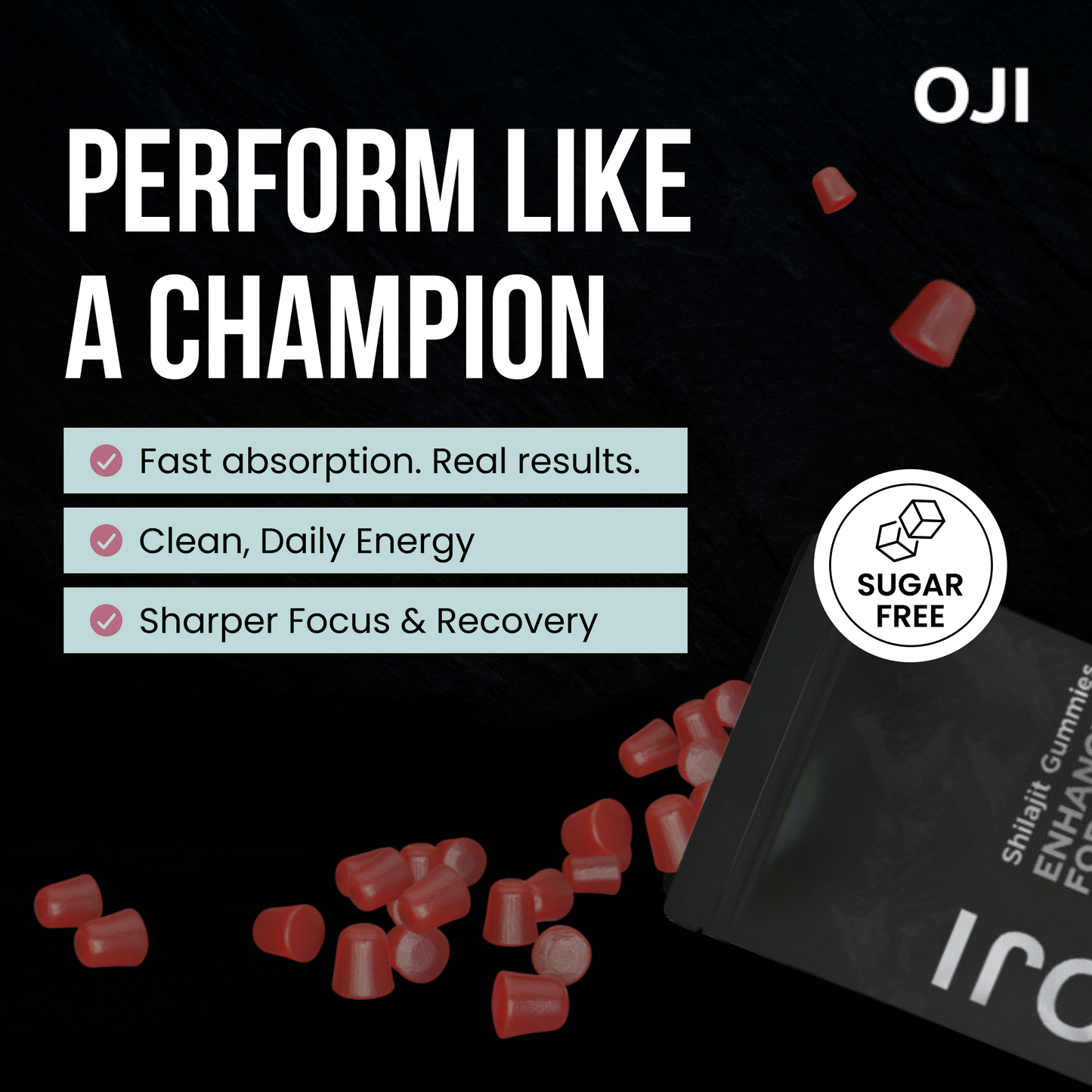To improve your VO2 max, you need a two-pronged attack: high-intensity training to push your performance ceiling higher, and dedicated endurance work to build a solid, unshakable foundation. This combination is the key to developing both top-end power and the aerobic efficiency you need for real, lasting progress. This guide provides the actionable steps to achieve it.
What VO2 Max Reveals About Your Fitness
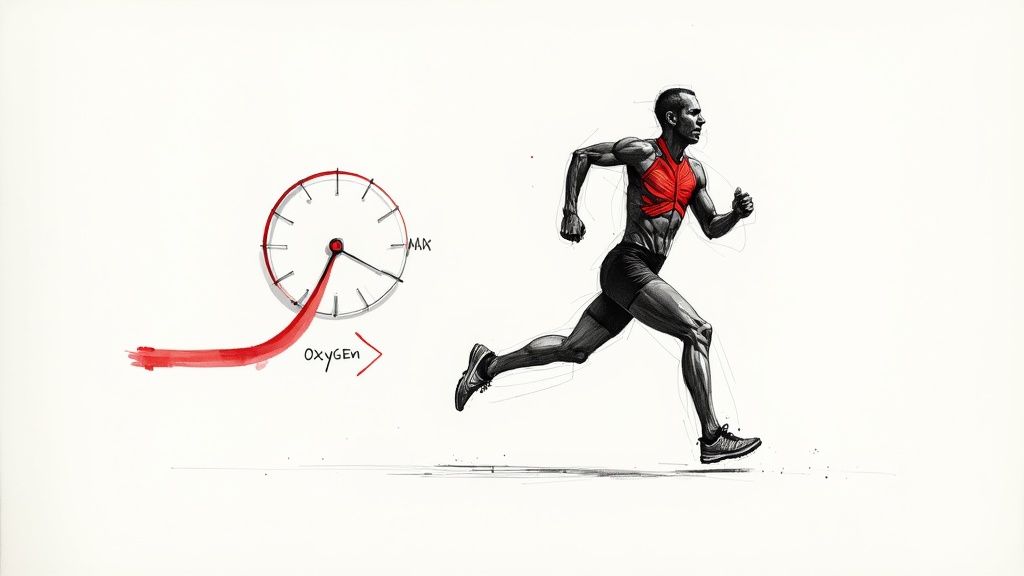
Before you start chasing a higher number, let's get clear on what VO2 max actually means. Think of it as your body's engine—it’s the maximum rate your heart, lungs, and muscles can effectively use oxygen when you're pushing hard.
This metric is the gold standard for measuring your cardiorespiratory fitness. A higher VO2 max means your body can take in and use more oxygen, which directly translates to a greater capacity for aerobic work.
Whether you're a seasoned athlete or just want to feel less out of breath climbing the stairs, this number is a powerful snapshot of your cardiovascular health and endurance potential. Knowing your VO2 max gives you a vital baseline to track your gains and set actionable goals.
Why Is VO2 Max Such a Key Fitness Metric?
Your VO2 max score, measured in millilitres of oxygen per kilogram of body weight per minute (mL/kg/min), tells the story of your entire cardiorespiratory system's efficiency. It's not just about lung size; it’s about how brilliantly your body delivers and uses oxygen at the cellular level.
This single number gives you insight because it’s a result of several systems working together:
- Heart Pumping Capacity: How much oxygen-rich blood your heart can push out with every beat.
- Oxygen-Carrying Capacity: The ability of your red blood cells to grab oxygen and get it to your working muscles.
- Muscular Oxygen Uptake: How well your muscle cells can extract that oxygen and use it to create energy.
To improve your VO2 max, you can take action to enhance any of these systems. For example, consistent endurance training increases the number of mitochondria—the energy factories in your cells—making your muscles far better at using oxygen.
VO2 max is more than just a number for athletes; it’s a vital sign of your overall health. A strong VO2 max is linked to better long-term health outcomes and a more resilient cardiovascular system.
Benchmarking Your Current Fitness Level
First, you need to know where you stand. VO2 max values can vary based on age, gender, genetics, and, most importantly, your activity level. An elite endurance athlete might clock in above 70 mL/kg/min, while a sedentary person of the same age could be below 30 mL/kg/min.
To give you a rough idea of where you might fall, here are some general reference values. Use these benchmarks to get a sense of your starting point.
VO2 Max Reference Values by Age and Activity Level (Men)
| Age Group | Sedentary | Active | Well-Trained |
|---|---|---|---|
| 20-29 | < 34 | 43-48 | > 52 |
| 30-39 | < 32 | 40-44 | > 48 |
| 40-49 | < 30 | 36-41 | > 45 |
| 50-59 | < 26 | 32-37 | > 41 |
| 60+ | < 24 | 30-34 | > 38 |
Your daily habits play a huge role. Improving your VO2 max is a critical part of boosting cardiovascular fitness. In the UK, values can differ depending on lifestyle. A historical study of male factory workers in 1979 found their average VO2 max was 29.9 mL/kg/min, which shows how your daily activity influences this metric. You can learn more about these UK demographic findings and what they mean for public health.
The good news is that consistent training leads to noticeable improvements. Many modern fitness trackers and smartwatches can give you a reliable estimate, offering a convenient way to track your progress without a formal lab test.
The Most Effective Workouts to Increase VO2 Max
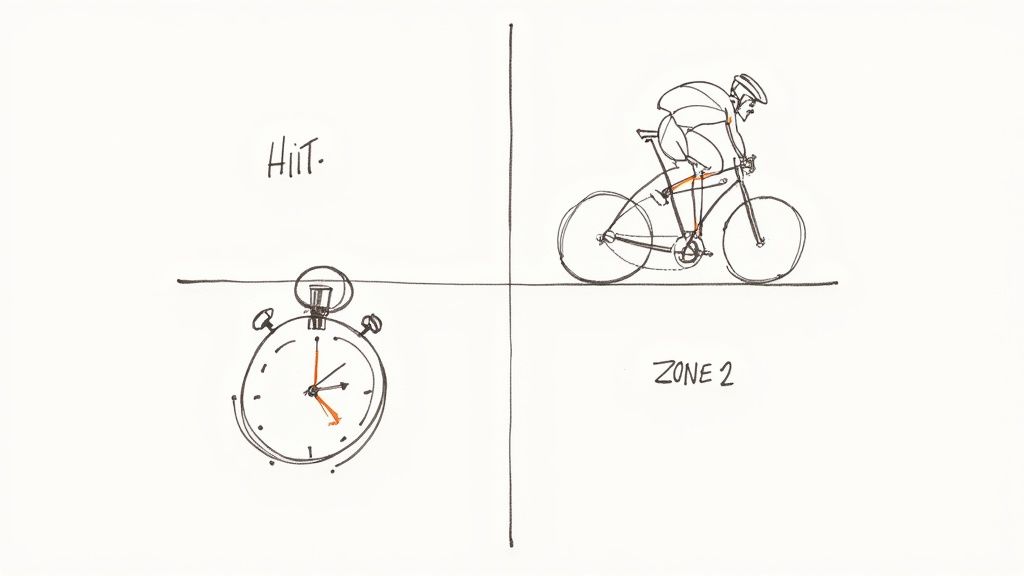
If you're serious about improving your VO2 max, you need to give your body a reason to adapt. That means getting comfortable with being uncomfortable. The biggest gains come from structured, intense workouts that push your cardiorespiratory system to its edge.
The most powerful tools are efficient and challenging HIIT workouts, which are legendary for improving cardiovascular fitness.
A smart training plan balances pushing your ceiling higher with building a solid aerobic foundation. Here are the exact workouts that get the job done.
The Power of High-Intensity Interval Training
When it comes to raising your VO2 max, High-Intensity Interval Training (HIIT) is the single most effective method. These sessions involve short, sharp bursts of almost all-out effort, broken up by brief recovery periods. This structure lets you spend more time at a high intensity than you could with one continuous effort, sending a powerful signal to your body to adapt.
The goal is to accumulate time working at or above 90% of your maximum heart rate. This is the red zone where your body is forced to get better at taking in and delivering oxygen. The intensity and structure are what count.
The magic of HIIT is its ability to force adaptation. By repeatedly pushing your system to its oxygen-processing limit, you trigger physiological changes, like increasing the amount of blood your heart pumps with each beat and boosting mitochondrial function.
Actionable VO2 Max Interval Structures
To put this into practice, here are tried-and-tested interval formats you can use for running, cycling, or rowing. Always perform a 10-15 minute warm-up before you start, and finish with a proper cool-down.
1. The 4x4 Minute Protocol
This is the gold standard for developing VO2 max. It's simple but incredibly effective.
- Action: Go hard for 4 minutes (aiming for 90-95% max heart rate), then take 3 minutes of active recovery (light jog or easy spin).
- Repetitions: Repeat this cycle 4 times. That’s 16 minutes of quality work.
- Why it works: The long interval duration forces you to spend significant time at your target VO2 max.
2. Shorter, Sharper Intervals (30/15s or 40/20s)
These are fantastic for pushing your limits and improving lactate tolerance.
- Action: 30 seconds of all-out effort, followed by 15 seconds of complete rest or very light recovery. Another option is 40 seconds on, 20 seconds off.
- Repetitions: Complete these in blocks. For instance, do one set of 10 repetitions of 30/15s, take a longer rest, and then go again for a second set.
- Why it works: The short rests don't let your heart rate drop completely, meaning you get back into the high-intensity zone much quicker.
A pro tip: try a "hard start" strategy. For a 4-minute interval, go a bit harder than your target pace for the first 30-45 seconds. This helps your aerobic system fire up faster, meaning you spend more of the interval in the productive, high-intensity zone.
Building Your Aerobic Base with Zone 2 Training
While HIIT raises your performance ceiling, Zone 2 training builds the foundation that holds it up. These are your longer, steadier sessions done at a conversational pace—usually between 60-70% of your maximum heart rate. You should be able to chat without gasping for air.
Zone 2 work drives an increase in your mitochondrial density. Mitochondria are the power plants in your muscle cells; the more you have, the better your body gets at using oxygen to create energy.
A strong aerobic base means you'll recover faster between tough intervals and be able to hold your pace for longer. Skipping this leads to burnout and plateaus. Keep it interesting by incorporating a mix of different stamina-building exercises.
Blending Your Workouts with Threshold and Fartlek Training
To build a well-rounded plan, weave in other types of workouts that bridge the gap between easy endurance and flat-out sprints.
-
Threshold Runs (Tempo): These are sustained efforts at a "comfortably hard" pace, typically around 80-90% of your max heart rate. A 20-40 minute tempo run trains your body to clear lactate more efficiently.
-
Fartlek Training: This Swedish term means "speed play." It's unstructured interval training. Mix faster periods with easier running based on how you feel. For example, sprint to the next lamppost, jog for two, then run hard up a small hill.
Here’s a simple way to look at how these workouts fit together:
| Workout Type | Intensity (RPE 1-10) | Primary Benefit | Example Session |
|---|---|---|---|
| VO2 Max Intervals | 9-10 | Increases max oxygen uptake | 4 x 4 minutes hard, 3 minutes easy |
| Zone 2 Training | 3-4 | Builds aerobic base, mitochondrial density | 60-90 minutes at a conversational pace |
| Threshold Training | 7-8 | Improves lactate clearance, sustained speed | 25 minutes at a comfortably hard pace |
| Fartlek Training | Varies (3-9) | Boosts fitness with less mental stress | 45-minute run with varied speed surges |
The secret is combining these elements intelligently. A balanced week could include one or two high-intensity VO2 max sessions, two or three Zone 2 sessions, and a threshold or fartlek workout, all built around proper recovery. This approach ensures you’re constantly challenging your body in different ways, leading to sustainable improvements.
Structuring Your Training for Long-Term Gains
Random workouts lead to random results. If you’re serious about bumping up your VO2 max, you need a structured plan. This is where training periodisation comes in—it's the method elite athletes use to organise their training into specific, purposeful blocks.
This is a smart way to manage your training load and recovery over weeks and months. By breaking your training down into clear phases, you can focus on building a solid foundation before piling on the high-intensity work needed to smash through your limits.
Step 1: Build Your Aerobic Base
Every journey to a higher VO2 max starts with a powerful aerobic engine. This first block of training, the base-building phase, is all about logging quality time in Zone 2. These are the longer, steadier efforts that build mitochondrial density and make your body a more efficient fat-burning machine.
For the first four to six weeks of any training cycle, your main action is to increase your capacity for work. This means most of your weekly training volume should be comfortable, conversational-pace sessions. A typical week might have three or four Zone 2 workouts, each lasting anywhere from 45 to 90 minutes.
You’re not chasing intensity here. You’re patiently laying the physiological groundwork that will support the tougher workouts to come. It's like building a skyscraper; without a solid foundation, you can't build up.
The infographic below shows how these phases fit together in a standard 12-week cycle.
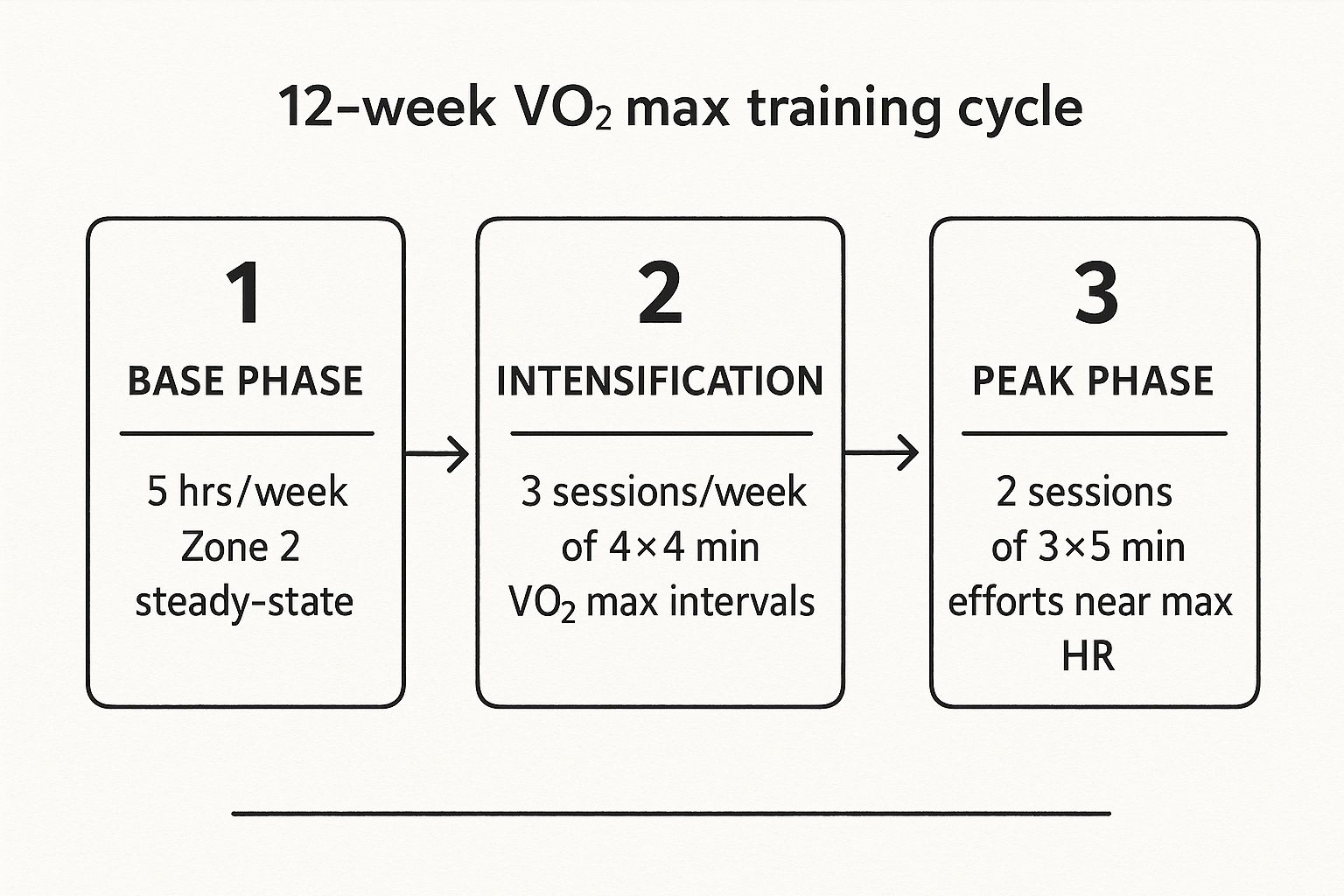
There’s a clear progression from high-volume, low-intensity base work to sharper, more specific efforts as you get closer to your goal.
Step 2: Intensification and Peak Phases
Once that solid aerobic base is in place, it’s time to add the fire. The intensification phase is where you start weaving in high-intensity interval training (HIIT) sessions. This is where you raise your aerobic ceiling.
During this four-week block, your action is to swap one or two of your Zone 2 sessions for targeted VO2 max intervals. These are the workouts that demand everything you've got, with efforts lasting between three to five minutes at an intensity close to your maximum heart rate.
- Actionable Workout 1: 4 x 4 minutes at 90-95% max heart rate, with 3 minutes of easy recovery between each interval.
- Actionable Workout 2: 5 x 3 minutes at a pace you could hold for an all-out 10-minute effort, with 2 minutes of light jogging to recover.
After this, move into the peak phase, which usually lasts two to three weeks. The action here is to dial back your overall training volume slightly while keeping the intensity of your key sessions high. This helps you shed fatigue, ensuring you show up to your race or test day sharp and ready to perform.
Advanced Training Strategies
For those looking for an extra edge, a couple of advanced methods are worth considering. Pyramid intervals are a popular one. This session involves a structured ladder of interval durations, challenging your body in a unique way.
A classic running pyramid workout might be:
- Ascend: 1 min hard, 2 mins hard, 3 mins hard (with equal recovery after each).
- Descend: 2 mins hard, 1 min hard (with equal recovery after each).
This structure keeps things mentally interesting and trains your body to cope with varying lengths of high-intensity work.
The biggest mistake athletes make is jumping straight into high-intensity training without a proper base. It’s a fast track to injury and burnout. Periodisation means you earn the right to train hard, leading to bigger, more sustainable gains.
Another technique is simulated altitude training. By working out in a low-oxygen environment, you can encourage your body to produce more red blood cells. This adaptation boosts your blood's oxygen-carrying capacity, which can translate to a higher VO2 max back at sea level. This is an advanced tool for experienced athletes.
Fuelling Your Body for Peak Aerobic Performance
Your hardest training sessions are only as good as the fuel you put in the tank. To push your VO2 max upwards, you need a smart nutrition strategy that supports your aerobic engine, giving it the energy to perform and the building blocks to recover.
Think of your body like a high-performance car. The most powerful engine is useless with low-grade fuel. Getting your nutrition right ensures you can hit the intensity needed in those VO2 max workouts and adapt from them.
Time Your Carbohydrates for Maximum Impact
Intense interval sessions run almost entirely on carbohydrates. Nailing your timing is a critical action.
Action: Have some carbs before a tough session to top up your muscle glycogen stores. Aim for a carb-rich snack or a small meal about 60-90 minutes before you start. This could be as simple as a banana, a slice of toast with jam, or a small bowl of porridge. The goal is easy-to-access energy.
Action: As soon as you finish, get carbs back in within 30-60 minutes post-workout. This helps to rapidly replenish what you’ve just burned and kicks off the recovery process. When short on time, some of the best protein bars for athletic performance can be a convenient way to get in vital post-workout nutrients.
The Critical Role of Iron in Oxygen Transport
You can have the strongest heart and lungs, but it’s for nothing if your blood can’t efficiently deliver oxygen. That’s where iron comes in. It's a fundamental part of haemoglobin, the protein in your red blood cells that carries oxygen.
An iron deficiency can cap your VO2 max, leaving you feeling tired and breathless. Endurance athletes are especially at risk due to iron losses through sweat and foot-strike haemolysis (the breakdown of red blood cells from the impact of running).
Action: To keep your iron levels topped up, make sure your diet includes plenty of these foods:
- Haem Iron (more easily absorbed): Lean red meat, poultry, and fish.
- Non-Haem Iron: Lentils, spinach, tofu, and fortified cereals.
Here’s a simple trick: to boost your absorption of non-haem iron (the plant-based kind), always pair it with a source of Vitamin C. Squeeze some lemon juice over a spinach salad, or have a glass of orange juice with your fortified cereal. If you’re constantly feeling tired despite getting enough rest, it’s well worth having a chat with your GP about getting your iron levels checked.
Evidence-Backed Supplements for an Aerobic Edge
While a solid diet is your foundation, a few specific supplements can give you a measurable boost. This is about targeted support for the physiological processes that contribute to a higher VO2 max.
Beetroot Juice for Nitrate Power
Beetroot juice is packed with dietary nitrates. Your body converts these into nitric oxide, a molecule that helps relax your blood vessels. This improves blood flow and reduces the oxygen cost of exercise, letting you hold a higher intensity for longer.
Beta-Alanine for Buffering Fatigue
During high-intensity intervals, your muscles produce lactic acid. Beta-alanine helps your body produce carnosine, a compound that acts as a buffer against this acid build-up. By delaying fatigue, it can help you squeeze out an extra rep.
Oji Shilajit for Mitochondrial Energy
Ultimately, your performance comes down to your mitochondria—the powerhouses inside your cells that generate energy. Oji Shilajit is a natural resin containing fulvic acid and over 85 trace minerals. It's thought to support mitochondrial function, helping to improve energy production and efficiency. By supporting your body's most fundamental energy systems, it can play a valuable role in your mission to raise your VO2 max.
For a deeper look into performance aids, you might be interested in our complete guide to supplements for endurance.
Mastering Recovery and Tracking Your Progress

The hard work you put in during training is only half the story. The real magic, where your body adapts and gets stronger, happens when you rest.
Without a smart approach to recovery and a clear way to track what you're doing, you’re just guessing. You're leaving potential gains on the table. This is where you turn effort into measurable results.
The Power of Smart Recovery
Recovery isn't just about crashing on the sofa. It's an active, essential part of any serious training plan.
Your most powerful tool is quality sleep. During sleep, your body releases growth hormone, repairs damaged muscle tissue, and cements adaptations. It’s non-negotiable.
Beyond sleep, active recovery plays a huge role. Action: Perform light movement on your rest days – a gentle walk, an easy spin on the bike, or some stretching. This gets blood flowing to your muscles, helping to flush out metabolic waste and reduce soreness without adding training stress.
For a deeper dive into bouncing back effectively, check out our guide on muscle recovery after a workout.
How to Actually See if It's Working
To know if your training is paying off, you need to look at a mix of hard data and how you feel.
Here are a few key things to track:
- Pace vs. Heart Rate: As you get fitter, you’ll be able to run or cycle faster while your heart rate stays the same. That's a sign of increased efficiency.
- How Hard It Feels (RPE): RPE, or Rating of Perceived Exertion, is how hard a workout felt on a scale of 1-10. If an interval session felt like an 8/10 a month ago and now feels more like a 6/10, you're making progress.
- Heart Rate Variability (HRV): Many fitness watches now track HRV. A higher HRV is generally a sign you're well-recovered and ready to go hard. If it’s consistently low, your body might need more rest.
Putting Your Fitness to the Test
While daily metrics show trends, regular fitness tests give you concrete proof that your VO₂ max is improving. You don't need a lab for this.
Actionable Test: Perform the Cooper Test. Simply run as far as you possibly can in 12 minutes. Do this every 4-6 weeks in similar conditions (same route, time of day). The trend is what matters. If your distance is increasing, your aerobic engine is improving.
This kind of regular check-in is crucial for seeing the bigger picture. After all, VO₂ max isn’t just for athletes; it’s a critical measure of your cardiorespiratory health and is linked to a reduced risk of cardiovascular disease.
To give you a clearer idea of how to structure your week, here's a sample schedule that balances intense training with crucial recovery.
Weekly Training and Recovery Schedule Example
| Day | Activity Focus | Example Session |
|---|---|---|
| Monday | HIIT | 5x3 minute intervals at 90% max effort with 2-minute jog recovery |
| Tuesday | Active Recovery | 30-45 minute easy walk or light cycling |
| Wednesday | Base Building | 60-75 minute run at a steady, conversational pace |
| Thursday | HIIT | 8x400m sprints with equal rest periods |
| Friday | Rest | Complete rest or very light stretching/mobility work |
| Saturday | Long Run | 90+ minute run at a comfortable, low-intensity pace |
| Sunday | Active Recovery | 45-minute walk or gentle yoga session |
This is just an example. The key is finding a rhythm that works for your body, allowing you to push hard on some days and properly recover on others.
By combining disciplined training with intelligent recovery and consistent tracking, you create a powerful feedback loop that drives sustainable improvements in your VO₂ max.
Common Questions on Improving VO2 Max
As you dive into VO2 max training, you're bound to have questions. Understanding the finer points of training and recovery can make all the difference. Let's tackle some common queries.
How Quickly Can I Realistically Improve My VO2 Max?
This depends on your starting point. If you’re just getting into structured training, you can see a 10-20% jump in just two or three months of consistent work. Your body is incredibly responsive to new challenges at this stage.
For seasoned athletes, the gains are much harder to earn. You might only see a 1-5% improvement over an entire training season. When you’re already highly trained, the game shifts to making small, precise adjustments and staying consistent.
Do I Need a Lab Test to Measure My VO2 Max?
While a lab test is the gold standard for accuracy, it's not a must-have. Modern fitness watches give a solid estimate using your heart rate and pace data. For tracking your own progress, that’s more than enough.
You can also get a reliable benchmark with a simple field test.
- The Cooper Test: Run as far as you possibly can in 12 minutes.
- The Key to Testing: The most important rule is consistency. Whichever test you choose, do it under the same conditions every 4-6 weeks to get a true picture of your improvement.
Should I Focus on HIIT or Long Slow Runs?
You need both. A smart training plan blends the two. High-Intensity Interval Training (HIIT) is your most powerful weapon for directly pushing up your VO2 max ceiling. These sessions force your heart and lungs to their limit, which triggers adaptation.
But long, slow runs (Zone 2 training) are the foundation. This builds your aerobic base, makes your body more efficient, and—crucially—allows you to recover from those brutal interval sessions. For the best results, aim for 1-2 HIIT sessions and 2-3 easier, longer efforts each week.
A common mistake is going all-out, all the time. Without that strong aerobic base from Zone 2 work, you’ll hit a plateau fast and increase your risk of burnout or injury.
Can Strength Training Improve My VO2 Max?
While lifting weights won’t directly increase your maximal oxygen uptake like cardio does, it plays a vital supporting role. A good strength routine improves your running or cycling economy—you use less oxygen at any given pace.
This improved efficiency means you can push harder and last longer during your key VO2 max workouts. Think of it as making your engine more fuel-efficient. A stronger core, legs, and upper body make you a more resilient, powerful athlete, which indirectly paves the way for better long-term gains.
To help your body produce energy at a cellular level and bounce back faster, consider adding a high-quality supplement to your daily routine. Oji Shilajit is packed with over 85 trace minerals and fulvic acid to support mitochondrial function, helping you get the absolute most out of every single training session. Explore the benefits of Oji Shilajit and fuel your progress today.


